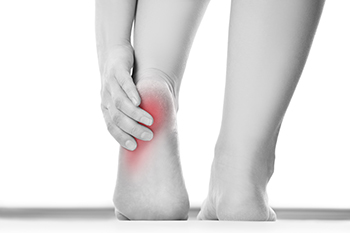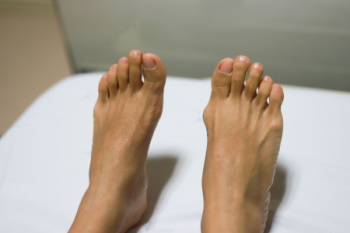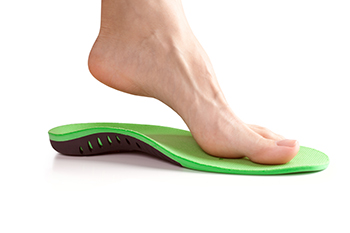
Quality of Life and Heel Pain
 Plantar heel pain, often caused by plantar fasciitis, can significantly impact quality of life. This condition occurs when the thick band of tissue running along the bottom of the foot becomes inflamed, typically due to overuse or strain. The resulting pain can make walking and standing difficult, limiting daily activities and reducing overall mobility. Factors such as wearing poor footwear, obesity, and prolonged standing contribute to this issue. To alleviate plantar heel pain, several measures can be taken. Wearing supportive shoes with proper arch support and cushioning is vital. Stretching exercises for the calf and foot can help relieve tension in the plantar fascia. Taking pain relievers can reduce inflammation and discomfort. In severe cases, custom orthotics may be necessary. If you have persistent heel pain, it is suggested that you schedule an appointment with a podiatrist for effective treatment and long-term relief.
Plantar heel pain, often caused by plantar fasciitis, can significantly impact quality of life. This condition occurs when the thick band of tissue running along the bottom of the foot becomes inflamed, typically due to overuse or strain. The resulting pain can make walking and standing difficult, limiting daily activities and reducing overall mobility. Factors such as wearing poor footwear, obesity, and prolonged standing contribute to this issue. To alleviate plantar heel pain, several measures can be taken. Wearing supportive shoes with proper arch support and cushioning is vital. Stretching exercises for the calf and foot can help relieve tension in the plantar fascia. Taking pain relievers can reduce inflammation and discomfort. In severe cases, custom orthotics may be necessary. If you have persistent heel pain, it is suggested that you schedule an appointment with a podiatrist for effective treatment and long-term relief.
Many people suffer from bouts of heel pain. For more information, contact one of our podiatrists of Foot Care Centers of Palm Beach. Our doctors can provide the care you need to keep you pain-free and on your feet.
Causes of Heel Pain
Heel pain is often associated with plantar fasciitis. The plantar fascia is a band of tissues that extends along the bottom of the foot. A rip or tear in this ligament can cause inflammation of the tissue.
Achilles tendonitis is another cause of heel pain. Inflammation of the Achilles tendon will cause pain from fractures and muscle tearing. Lack of flexibility is also another symptom.
Heel spurs are another cause of pain. When the tissues of the plantar fascia undergo a great deal of stress, it can lead to ligament separation from the heel bone, causing heel spurs.
Why Might Heel Pain Occur?
- Wearing ill-fitting shoes
- Wearing non-supportive shoes
- Weight change
- Excessive running
Treatments
Heel pain should be treated as soon as possible for immediate results. Keeping your feet in a stress-free environment will help. If you suffer from Achilles tendonitis or plantar fasciitis, applying ice will reduce the swelling. Stretching before an exercise like running will help the muscles. Using all these tips will help make heel pain a condition of the past.
If you have any questions please contact our office located in Boynton Beach, FL . We offer the newest diagnostic and treatment technologies for all your foot and ankle needs.
Heel Pain
Heel pain can be difficult to deal with, especially if you do not know what the underlying cause is. If you ignore your heel pain, the pain can magnify and potentially develop into a chronic condition. Depending on the location of your heel pain, you have developed a specific condition.
One condition is plantar fasciitis. Plantar fasciitis is caused by the inflammation of the plantar fascia, or the band of tissue that connects the heel bone to the base of the toes. The pain from this condition is initially mild but can intensify as more steps are taken when you wake up in the morning. To treat this condition, medication will likely be necessary. Plantar fasciitis is often associated with heel spurs; both require rest and special stretching exercises.
There are various options your podiatrist may suggest for heel pain. Treatment options for heel pain typically include non-steroidal anti-inflammatory drugs (NSAIDS), which may reduce swelling and pain. Other options are physical therapy, athletic taping, and orthotics. In severe cases of heel pain, surgery may be required.
Preventing heel pain is possible. If you are looking to prevent heel pain from developing in the future, be sure to wear shoes that fit you properly and do not have worn down heels or soles. Be sure to warm up properly before participating in strenuous activities or sports that place a lot of a stress on the heels. If you are experiencing any form of heel pain, speak with your podiatrist to determine the underlying cause and receive the treatment you need.
Custom Orthotics For Ankle Stability

Step with assurance, thanks to enhanced ankle stability from orthotics! If you're active and on the move, Custom Orthotics are your ally for stronger, steadier ankles. They align your foot and ankle, reducing the risk of sprains and offering solid support for every stride. Don’t let instability hold you back. Try Custom Orthotics from our office, and discover unshakable confidence in every step!
Tending to Bunions
 Bunions are bony bumps that form on the joint at the base of the big toe, causing the toe to deviate towards the other toes. They appear as swollen, protruding lumps on the side of the foot and can be red and tender. The condition can cause significant discomfort, including pain, swelling, and restricted movement of the big toe. Bunions often develop due to inherited foot structure, wearing tight or ill-fitting shoes, arthritis, or excessive stress on the feet. High heels and pointed shoes are common culprits in exacerbating bunions. Symptoms typically include pain, especially while walking, and inflammation surrounding the affected joint. Treatment for bunions ranges from conservative measures to surgery. Wearing wider shoes, using bunion pads, and taking anti-inflammatory medications can help to alleviate symptoms. Orthotic devices may help correct foot alignment. In severe cases, surgical intervention may be necessary to realign the bone and relieve pain. Untreated bunions can lead to complications such as bursitis or hammertoes. If you have a bunion that is causing you discomfort, it is suggested that you schedule an appointment with a podiatrist for treatment.
Bunions are bony bumps that form on the joint at the base of the big toe, causing the toe to deviate towards the other toes. They appear as swollen, protruding lumps on the side of the foot and can be red and tender. The condition can cause significant discomfort, including pain, swelling, and restricted movement of the big toe. Bunions often develop due to inherited foot structure, wearing tight or ill-fitting shoes, arthritis, or excessive stress on the feet. High heels and pointed shoes are common culprits in exacerbating bunions. Symptoms typically include pain, especially while walking, and inflammation surrounding the affected joint. Treatment for bunions ranges from conservative measures to surgery. Wearing wider shoes, using bunion pads, and taking anti-inflammatory medications can help to alleviate symptoms. Orthotic devices may help correct foot alignment. In severe cases, surgical intervention may be necessary to realign the bone and relieve pain. Untreated bunions can lead to complications such as bursitis or hammertoes. If you have a bunion that is causing you discomfort, it is suggested that you schedule an appointment with a podiatrist for treatment.
If you are suffering from bunions, contact one of our podiatrists of Foot Care Centers of Palm Beach. Our doctors can provide the care you need to keep you pain-free and on your feet.
What Is a Bunion?
A bunion is formed of swollen tissue or an enlargement of boney growth, usually located at the base joint of the toe that connects to the foot. The swelling occurs due to the bones in the big toe shifting inward, which impacts the other toes of the foot. This causes the area around the base of the big toe to become inflamed and painful.
Why Do Bunions Form?
Genetics – Susceptibility to bunions are often hereditary
Stress on the feet – Poorly fitted and uncomfortable footwear that places stress on feet, such as heels, can worsen existing bunions
How Are Bunions Diagnosed?
Doctors often perform two tests – blood tests and x-rays – when trying to diagnose bunions, especially in the early stages of development. Blood tests help determine if the foot pain is being caused by something else, such as arthritis, while x-rays provide a clear picture of your bone structure to your doctor.
How Are Bunions Treated?
- Refrain from wearing heels or similar shoes that cause discomfort
- Select wider shoes that can provide more comfort and reduce pain
- Anti-inflammatory and pain management drugs
- Orthotics or foot inserts
- Surgery
If you have any questions, please feel free to contact our office located in Boynton Beach, FL . We offer the newest diagnostic and treatment technologies for all your foot care needs.
What Are Bunions?
Bunions are large bony bumps at the base of the big toe. Medically known as hallux valgus, a bunion is a misalignment of the metatarsophalangeal joint, or big toe joint. The misalignment will generally worsen with time if left untreated.
The exact cause of bunions is unknown, with genetics seen as a potential cause. High heels and poorly-fitted footwear, rheumatoid arthritis, and heredity all seem to be potential factors behind the exacerbation of bunions. Women have been found to be more likely to develop bunions in comparison to men.
Bunions do not always produce symptoms. The best way to tell is if the big toe is pushing up against the next toe and there is a large protrusion at the base of the big toe. You may or may not feel pain. Redness, swelling, and restricted movement of the big toe may be present as well.
Podiatrists use a variety of methods to diagnose bunions. If there are symptoms present, podiatrists will first consider that it is a bunion. If not, a physical examination will be conducted to check function of the big toe. Finally, an X-ray may be taken to view the extent of the bunion and confirm it is a bunion.
Typically, nonsurgical methods are used to treat bunions, unless the bunion has become too misaligned. Orthotics, icing and resting the foot, roomier and better fitted shoes, taping the foot, and pain medication are usually utilized first. If the bunion doesn’t go away or causes extreme pain, surgery may be required. Surgeons will either remove part of the swollen tissue or bone to straighten the toe out.
If you have a bunion, it is recommended to see a podiatrist. The longer it is left untreated, the worse it may get. Podiatrists can properly diagnose and treat a bunion before it gets worse.
The Power of Foot Orthotics

Podiatrists wield a transformative tool in their arsenal, which are custom-made foot orthotics. As guardians of foot health, they meticulously assess and prescribe these individualized wonders to address a spectrum of ailments. With keen insight into biomechanics, they tailor orthotics to the unique needs of each patient, correcting imbalances and restoring equilibrium. From flat feet to plantar fasciitis, orthotics provide targeted support, alleviating pain and enhancing mobility. Podiatrists recognize that foot health is foundational to overall well-being, and thus, they harness the potential of orthotics to foster long-term vitality. With thorough evaluations and precise fittings, they empower patients to reclaim control over their foot health, guiding them toward a future free from limitations. Orthotics prescribed by podiatrists transcend mere comfort. They serve to enable individuals to stride confidently toward a life of pain-free movement and vitality. In the hands of a skilled podiatrist, foot orthotics emerge not just as remedies, but as beacons of hope. Wearing custom-made orthotics can relieve a multitude of foot conditions. If you have a foot ailment that can benefit from wearing orthotics, it is suggested that you seek the advice of a podiatrist.
If you are experiencing discomfort in your feet and would like to try custom orthotics, contact one of our podiatrists from Foot Care Centers of Palm Beach. Our doctors can provide the care you need to keep you pain-free and on your feet.
What Are Custom Orthotics?
Custom orthotics are inserts you can place into your shoes to help with a variety of foot problems such as flat feet or foot pain. Orthotics provide relief and comfort for minor foot and heel pain.
Over-the-Counter Inserts
Shoe inserts come in a wide variety and are used to treat foot pain, heel pain, and minor problems. For example, arch supports can be inserted into your shoes to help correct overarched or flat feet, while gel insoles are often used because they provide comfort and relief from foot and heel pain by alleviating pressure.
Prescription Orthotics
If over-the-counter inserts don’t work for you or if you have a more severe foot concern, it is possible to have your podiatrist prescribe custom orthotics. These high-quality, custom inserts are designed to treat problems such as abnormal motion, plantar fasciitis, and severe forms of heel pain. They can even be used to help patients suffering from diabetes by treating foot ulcers and painful calluses and are usually molded to your feet individually, which allows them to provide full support and comfort.
If you're experiencing minor to severe foot or heel pain, it’s recommended to speak with your podiatrist about the possibility of using custom orthotics or shoe inserts. A podiatrist can determine which type of custom orthotic or shoe insert is right for you and help you take the first steps toward being pain-free.
If you have any questions please contact our office located in Boynton Beach, FL . We offer the newest diagnostic and treatment technologies for all your foot and ankle needs.
Investing in Custom Orthotics Means Investing in Foot Health
Custom orthotics offer a tailored approach to foot health, providing a host of benefits that extend far beyond conventional shoe inserts. One of the primary advantages lies in their ability to address specific biomechanical issues. Unlike off-the-shelf inserts, custom orthotics are crafted based on an individual's unique foot structure, gait, and any existing foot conditions.
The personalized design of custom orthotics ensures optimal support for the arches, promoting proper alignment and distributing pressure evenly across the feet. This can be particularly beneficial for individuals dealing with issues such as overpronation or underpronation, as custom orthotics help correct imbalances that may lead to discomfort or injury.
Beyond biomechanics, custom orthotics can alleviate a range of foot problems, including plantar fasciitis, bunions, and metatarsalgia. They provide targeted relief to areas under stress, reducing pain and inflammation. Additionally, for those with specific medical conditions like diabetes, custom orthotics can play a crucial role in preventing complications associated with poor foot health.
Comfort is another key aspect of custom orthotics. By accommodating the unique contours of an individual's feet, these inserts enhance overall comfort, making daily activities more enjoyable. Whether for athletes looking to optimize performance or individuals seeking relief from chronic foot pain, custom orthotics offer a versatile solution.
Investing in custom orthotics is an investment in long-term foot health. They not only provide immediate relief but also contribute to the prevention of future issues. With the ability to seamlessly integrate into various types of footwear, custom orthotics empower individuals to prioritize foot comfort without compromising on style. In essence, custom orthotics are a personalized prescription for happy, healthy, and pain-free feet.
Various Foot Fractures and Relief Strategies

Foot fractures encompass a spectrum of injuries, each demanding specific attention and care. Among them, the Jones fracture affects the fifth metatarsal bone, typically requiring immobilization through casting or surgery to ensure proper healing. Metatarsal shaft fractures, occurring along the long bones of the foot, often necessitate rest, elevation, and the use of crutches to alleviate pressure. Proximal fifth metatarsal tuberosity avulsion fractures involve the pulling away of a small bone fragment due to sudden muscle contractions, often managed with immobilization and gradual return to weight-bearing activities. Additionally, big toe fractures, whether simple or complex, may require splinting, taping, or buddy taping to adjacent toes to promote stability. Relief techniques for foot fractures commonly involve rest and elevation to mitigate swelling and pain. Immobilization aids like casts, braces, or boots help stabilize the injured area, facilitating proper healing. If you have broken your foot, it is strongly suggested that you consult a podiatrist who can determine what type of fracture you have, and offer appropriate treatment methods.
A broken foot requires immediate medical attention and treatment. If you need your feet checked, contact one of our podiatrists from Foot Care Centers of Palm Beach. Our doctors can provide the care you need to keep you pain-free and on your feet.
Broken Foot Causes, Symptoms, and Treatment
A broken foot is caused by one of the bones in the foot typically breaking when bended, crushed, or stretched beyond its natural capabilities. Usually the location of the fracture indicates how the break occurred, whether it was through an object, fall, or any other type of injury.
Common Symptoms of Broken Feet:
- Bruising
- Pain
- Redness
- Swelling
- Blue in color
- Numbness
- Cold
- Misshapen
- Cuts
- Deformities
Those that suspect they have a broken foot shoot seek urgent medical attention where a medical professional could diagnose the severity.
Treatment for broken bones varies depending on the cause, severity and location. Some will require the use of splints, casts or crutches while others could even involve surgery to repair the broken bones. Personal care includes the use of ice and keeping the foot stabilized and elevated.
If you have any questions please feel free to contact our office located in Boynton Beach, FL . We offer the newest diagnostic and treatment technologies for all your foot and ankle needs.
Causes, Symptoms, and Treatment for a Broken Foot
One out of ten broken bones is reported to be in the feet. When an object crushes, bends, or stretches the bone beyond acceptable ranges, bones break. A break in the foot is either a fracture or a straight break.
The location of any break can tell you how the break happened. Toes, for instance, break typically as a result of something being kicked hard and with great force. Heel breaks almost always are a result of an improper landing from a tall height. Twists or sprains are the other two frequent occurrences. As with all usual breaks, they result from unexpected accident or sudden injury. As with stress fractures, breaks form as a process over time from repeated stress on already present cracks. Runners, dancers, and gymnasts are the usual athletes who receive this type of break. Stress fractures result from incredible pressure on the feet. It is no surprise these athletes bear the majority of reported fractures.
Pain, swelling, bruising, and redness are all indicative of the typical symptoms from a broken foot. Severe pain—to the point of not being able to walk—usually depends on the location of the break in the foot. Toes are on the lower scale of pain threshold, but heels are high, as are a few other particular bones. As the severity of the broken foot increases, symptoms like blueness, numbness, misshaping of the foot, cuts, or deformities will become apparent. These symptoms indicate the need to see a medical professional with access to an x-ray facility.
Prior to seeing a specialist, precautions should be taken to reduce pain and swelling. Elevate and stabilize the foot, and refrain from moving it. Immobilization of the foot is the next priority, so creating a homemade splint is acceptable. Keep in mind that while creating a splint, any increase of pain or cutting off blood circulation means that the splint should be removed immediately. Use ice to decrease swelling and relieve pain symptoms.
When dealing with a medical center, the patient should note that the treatment can vary. The treatment will depend on the severity of the fracture and the cause of the break. Crutches, splits, or casts are common treatments while surgery has been known to be used in more severe cases in order to repair the break in the bones.







